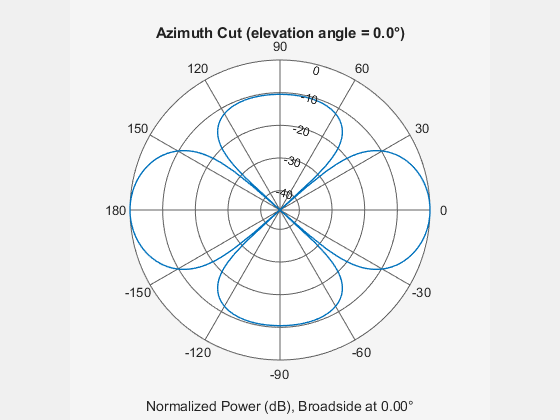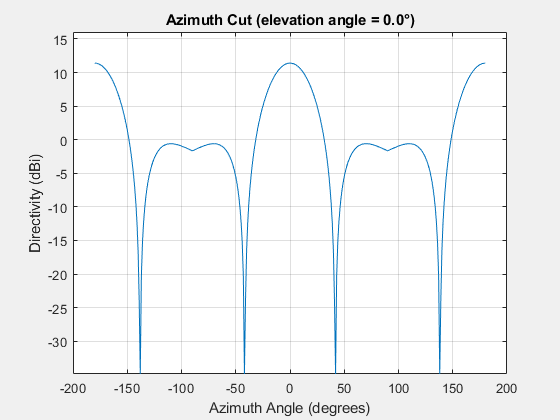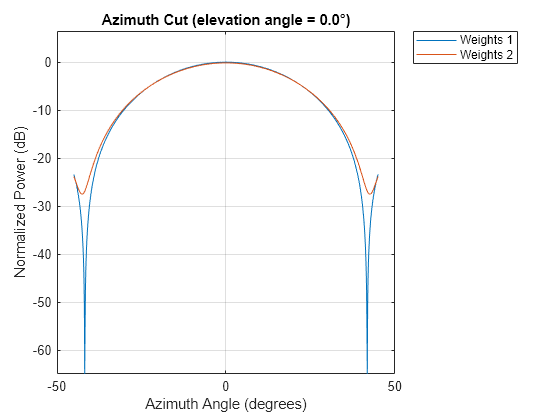pattern
System object: phased.HeterogeneousURA
Namespace: phased
Plot heterogeneous URA directivity and power pattern
Syntax
pattern(sArray,FREQ)
pattern(sArray,FREQ,AZ)
pattern(sArray,FREQ,AZ,EL)
pattern(___,Name,Value)
[PAT,AZ_ANG,EL_ANG] = pattern(___)
Description
pattern( plots
the 3-D array directivity pattern (in dBi) for the array specified
in sArray,FREQ)sArray. The operating frequency is specified
in FREQ.
The integration used when computing array directivity has a minimum sampling grid of 0.1 degrees. If an array pattern has a beamwidth smaller than this, the directivity value will be inaccurate.
pattern( plots
the array directivity pattern at the specified azimuth angle.sArray,FREQ,AZ)
pattern( plots
the array directivity pattern at specified azimuth and elevation angles.sArray,FREQ,AZ,EL)
pattern(___,
plots the array pattern with additional options specified by one or
more Name,Value)Name,Value pair arguments.
[PAT,AZ_ANG,EL_ANG] = pattern(___)PAT. The AZ_ANG output
contains the coordinate values corresponding to the rows of PAT.
The EL_ANG output contains the coordinate values
corresponding to the columns of PAT. If the 'CoordinateSystem' parameter
is set to 'uv', then AZ_ANG contains
the U coordinates of the pattern and EL_ANG contains
the V coordinates of the pattern. Otherwise, they
are in angular units in degrees. UV units are dimensionless.
Note
When you need to compute array or element directivity, you can either set the
Type property to "directivity" in the
pattern object function or use the directivity
object function. For a small number of angular directions, it may be more computationally
efficient to use the directivity object function. The
pattern object function is more efficient for computing directivity
for larger angular regions.
Input Arguments
Heterogeneous conformal array, specified as a phased.HeterogeneousURA System object.
Example: sArray= phased.HeterogeneousURA;
Frequencies for computing directivity and patterns, specified as a positive scalar or 1-by-L real-valued row vector. Frequency units are in hertz.
For an antenna, microphone, or sonar hydrophone or projector element,
FREQmust lie within the range of values specified by theFrequencyRangeorFrequencyVectorproperty of the element. Otherwise, the element produces no response and the directivity is returned as–Inf. Most elements use theFrequencyRangeproperty except forphased.CustomAntennaElementandphased.CustomMicrophoneElement, which use theFrequencyVectorproperty.For an array of elements,
FREQmust lie within the frequency range of the elements that make up the array. Otherwise, the array produces no response and the directivity is returned as–Inf.
Example: [1e8 2e6]
Data Types: double
Azimuth angles for computing directivity and pattern, specified as a 1-by-N real-valued row vector where N is the number of azimuth angles. Angle units are in degrees. Azimuth angles must lie between –180° and 180°.
The azimuth angle is the angle between the x-axis and the projection of the direction vector onto the xy plane. When measured from the x-axis toward the y-axis, this angle is positive.
Example: [-45:2:45]
Data Types: double
Elevation angles for computing directivity and pattern, specified as a 1-by-M real-valued row vector where M is the number of desired elevation directions. Angle units are in degrees. The elevation angle must lie between –90° and 90°.
The elevation angle is the angle between the direction vector and xy-plane. The elevation angle is positive when measured towards the z-axis.
Example: [-75:1:70]
Data Types: double
Name-Value Arguments
Specify optional pairs of arguments as
Name1=Value1,...,NameN=ValueN, where Name is
the argument name and Value is the corresponding value.
Name-value arguments must appear after other arguments, but the order of the
pairs does not matter.
Before R2021a, use commas to separate each name and value, and enclose
Name in quotes.
Plotting coordinate system of the pattern, specified as the comma-separated pair consisting of
CoordinateSystem and one of "polar",
"rectangular", or "uv". When
CoordinateSystem is set to "polar" or
"rectangular", the AZ and
EL arguments specify the pattern azimuth and elevation,
respectively. AZ values must lie between –180° and 180°.
EL values must lie between –90° and 90°. If
CoordinateSystem is set to "uv",
AZ and EL then specify
U and V coordinates, respectively.
AZ and EL must lie between -1 and
1.
Example: "uv"
Data Types: char
Displayed pattern type, specified as the equal-sign-separated pair consisting of
Type and one of
"directivity"— directivity pattern measured in dBi."efield"— field pattern of the sensor or array. For acoustic sensors, the displayed pattern is for the scalar sound field."power"— power pattern of the sensor or array defined as the square of the field pattern."powerdb"— power pattern converted to dB.
Example: "powerdb"
Data Types: char
Array orientation, specified as a 3-by-1 real-valued column vector containing three rotation angles. The three angles define orthogonal rotations with respect to the x-, y-, and z-axes of the local coordinate system. To create the full orientation matrix, the orthogonal rotations are applied in this order:
a rotation around the positive x-axis by the angle θx.
a rotation around the positive y-axis by the angle θy.
a rotation around the positive z-axis by the angle θz.
Positive angles are defined using the right-handed rule. A positive angle defines a rotation that appears clockwise when looking towards the positive direction of the axis, and negative values when the rotation appears counter-clockwise. The right-hand rule is invoked by pointing the right-hand thumb along an axis. Then the other fingers of the right hand curl in the positive direction,
Display normalized pattern, specified as the comma-separated pair consisting of
Normalize and a Boolean. Set this parameter to
true to display a normalized pattern. This parameter does not
apply when you set Type to "directivity".
Directivity patterns are already normalized.
Data Types: logical
View the array geometry along with the 3D radiation pattern, specified as
false or true.
Data Types: logical
Show the local coordinate axes, specified as true or false.
Data Types: logical
Show the colorbar, specified as true or false.
Data Types: logical
Handle to the axes along which the array geometry is displayed specified as a scalar.
Polarized field component to display, specified as the comma-separated pair consisting of
'Polarization' and 'combined', 'H', or
'V'. This parameter applies only when the sensors are
polarization-capable and when the 'Type' parameter is not set to
'directivity'. This table shows the meaning of the display
options.
'Polarization' | Display |
|---|---|
'combined' | Combined H and V polarization components |
'H' | H polarization component |
'V' | V polarization component |
Example: 'V'
Data Types: char
Signal propagation speed, specified as the comma-separated pair consisting of
PropagationSpeed and a positive scalar in meters per
second.
Example: PropagationSpeed="physconst('LightSpeed')"
Data Types: double
Array weights, specified as the comma-separated pair consisting
of 'Weights' and an N-by-1 complex-valued
column vector or N-by-L complex-valued
matrix. Array weights are applied to the elements of the array to
produce array steering, tapering, or both. The dimension N is
the number of elements in the array. The dimension L is
the number of frequencies specified by FREQ.
| Weights Dimension | FREQ Dimension | Purpose |
|---|---|---|
| N-by-1 complex-valued column vector | Scalar or 1-by-L row vector | Applies a set of weights for the single frequency or for all L frequencies. |
| N-by-L complex-valued matrix | 1-by-L row vector | Applies each of the L columns of 'Weights' for
the corresponding frequency in FREQ. |
Note
Use complex weights to steer the array response toward different
directions. You can create weights using the phased.SteeringVector System object or
you can compute your own weights. In general, you apply Hermitian
conjugation before using weights in any Phased Array System Toolbox™ function
or System object such as phased.Radiator or phased.Collector. However, for the directivity, pattern, patternAzimuth,
and patternElevation methods of any array System object use
the steering vector without conjugation.
Example: 'Weights',ones(N,M)
Data Types: double
Complex Number Support: Yes
Output Arguments
Examples
Construct a 3-by-3 heterogeneous URA of short-dipole antenna elements with a rectangular lattice. Then, plot the array's azimuth pattern at 300 MHz.
sElement1 = phased.ShortDipoleAntennaElement(... 'FrequencyRange',[2e8 5e8],... 'AxisDirection','Z'); sElement2 = phased.ShortDipoleAntennaElement(... 'FrequencyRange',[2e8 5e8],... 'AxisDirection','Y'); sArray = phased.HeterogeneousURA(... 'ElementSet',{sElement1,sElement2},... 'ElementIndices',[1 1 1; 2 2 2; 1 1 1]); fc = 300e6; c = physconst('LightSpeed'); pattern(sArray,fc,[-180:180],0,... 'PropagationSpeed',c,... 'CoordinateSystem','rectangular',... 'Type','powerdb',... 'Normalize',true,... 'Polarization','combined')

Plot the same result in polar form.
pattern(sArray,fc,[-180:180],0,... 'PropagationSpeed',c,... 'CoordinateSystem','polar',... 'Type','powerdb',... 'Normalize',true,... 'Polarization','combined')

Finally, plot the directivity.
pattern(sArray,fc,[-180:180],0,... 'PropagationSpeed',c,... 'CoordinateSystem','rectangular',... 'Type','directivity')

Construct a square 3-by-3 heterogeneous URA composed of 9 short-dipole antenna elements with different orientations. Plot the array azimuth pattern from -45 degrees to 45 degrees in 0.1 degree increments. The Weights parameter lets you display the array pattern simultaneously for different sets of weights: in this case a uniform set of weights and a tapered set.
sElement1 = phased.ShortDipoleAntennaElement(... 'FrequencyRange',[2e8 5e8],... 'AxisDirection','Z'); sElement2 = phased.ShortDipoleAntennaElement(... 'FrequencyRange',[2e8 5e8],... 'AxisDirection','Y'); sArray = phased.HeterogeneousURA(... 'ElementSet',{sElement1,sElement2},... 'ElementIndices',[1 1 1; 2 2 2; 1 1 1]); fc = [3e8]; c = physconst('LightSpeed'); wts1 = ones(9,1)/9; wts2 = [.7,.7,.7,.7,1,.7,.7,.7,.7]'; wts2 = wts2/sum(wts2); pattern(sArray,fc,[-45:0.1:45],0,... 'PropagationSpeed',c,... 'CoordinateSystem','rectangular',... 'Type','powerdb',... 'Weights',[wts1,wts2],... 'Polarization','combined')

More About
Directivity describes the directionality of the radiation pattern of a sensor element or array of sensor elements.
Higher directivity is desired when you want to transmit more radiation in a specific direction. Directivity is the ratio of the transmitted radiant intensity in a specified direction to the radiant intensity transmitted by an isotropic radiator with the same total transmitted power
where Urad(θ,φ) is the radiant intensity of a transmitter in the direction (θ,φ) and Ptotal is the total power transmitted by an isotropic radiator. For a receiving element or array, directivity measures the sensitivity toward radiation arriving from a specific direction. The principle of reciprocity shows that the directivity of an element or array used for reception equals the directivity of the same element or array used for transmission. When converted to decibels, the directivity is denoted as dBi. For information on directivity, read the notes on Element Directivity and Array Directivity.
For antenna, microphone, and array System objects, the pattern method
replaces the plotResponse method. In addition, two new simplified
methods exist just to draw 2-D azimuth and elevation pattern plots. These methods are
patternAzimuth and patternElevation.
The following table is a guide for converting your code from
using plotResponse to pattern.
Notice that some of the inputs have changed from input arguments to Name-Value pairs
and conversely. The general pattern method syntax
is
pattern(H,FREQ,AZ,EL,'Name1','Value1',...,'NameN','ValueN')
| plotResponse Inputs | plotResponse Description | pattern Inputs | ||||||||||||||||||||
|---|---|---|---|---|---|---|---|---|---|---|---|---|---|---|---|---|---|---|---|---|---|---|
H argument | Antenna, microphone, or array System object. | H argument (no change) | ||||||||||||||||||||
FREQ argument | Operating frequency. | FREQ argument (no change) | ||||||||||||||||||||
V argument | Propagation speed. This argument is used only for arrays. | 'PropagationSpeed' name-value pair. This
parameter is only used for arrays. | ||||||||||||||||||||
'Format' and 'RespCut' name-value
pairs | These options work together to let you create a plot
in angle space (line or polar style) or UV space.
They also determine whether the plot is 2-D or 3-D. This table shows
you how to create different types of plots using
|
If you set | ||||||||||||||||||||
'CutAngle' name-value pair | Constant angle at to take an azimuth or elevation cut. When
producing a 2-D plot and when 'RespCut' is set
to 'Az' or 'El', use 'CutAngle' to
set the slice across which to view the plot. | No equivalent name-value pair. To create a cut, specify either AZ or EL as
a scalar, not a vector. | ||||||||||||||||||||
'NormalizeResponse' name-value pair | Normalizes the plot. When 'Unit' is set
to 'dbi', you cannot specify 'NormalizeResponse'. | Use the | ||||||||||||||||||||
'OverlayFreq' name-value pair | Plot multiple frequencies on the same 2-D plot. Available only
when 'Format' is set to 'line' or 'uv' and 'RespCut' is
not set to '3D'. The value true produces
an overlay plot and the value false produces a
waterfall plot. |
The values | ||||||||||||||||||||
'Polarization' name-value pair | Determines how to plot polarized fields. Options are 'None', 'Combined', 'H',
or 'V'. | 'Polarization' name-value pair determines
how to plot polarized fields. The 'None' option
is removed. The options 'Combined', 'H',
or 'V' are unchanged. | ||||||||||||||||||||
'Unit' name-value pair | Determines the plot units. Choose 'db', 'mag', 'pow',
or 'dbi', where the default is 'db'. |
| ||||||||||||||||||||
'Weights' name-value pair | Array element tapers (or weights). | 'Weights' name-value pair (no change). | ||||||||||||||||||||
'AzimuthAngles' name-value pair | Azimuth angles used to display the antenna or array response. |
| ||||||||||||||||||||
'ElevationAngles' name-value pair | Elevation angles used to display the antenna or array response. |
| ||||||||||||||||||||
'UGrid' name-value pair | Contains U coordinates in UV-space. |
| ||||||||||||||||||||
'VGrid' name-value pair | Contains V-coordinates in UV-space. |
|
Version History
Introduced in R2015a
See Also
MATLAB Command
You clicked a link that corresponds to this MATLAB command:
Run the command by entering it in the MATLAB Command Window. Web browsers do not support MATLAB commands.
Website auswählen
Wählen Sie eine Website aus, um übersetzte Inhalte (sofern verfügbar) sowie lokale Veranstaltungen und Angebote anzuzeigen. Auf der Grundlage Ihres Standorts empfehlen wir Ihnen die folgende Auswahl: .
Sie können auch eine Website aus der folgenden Liste auswählen:
So erhalten Sie die bestmögliche Leistung auf der Website
Wählen Sie für die bestmögliche Website-Leistung die Website für China (auf Chinesisch oder Englisch). Andere landesspezifische Websites von MathWorks sind für Besuche von Ihrem Standort aus nicht optimiert.
Amerika
- América Latina (Español)
- Canada (English)
- United States (English)
Europa
- Belgium (English)
- Denmark (English)
- Deutschland (Deutsch)
- España (Español)
- Finland (English)
- France (Français)
- Ireland (English)
- Italia (Italiano)
- Luxembourg (English)
- Netherlands (English)
- Norway (English)
- Österreich (Deutsch)
- Portugal (English)
- Sweden (English)
- Switzerland
- United Kingdom (English)